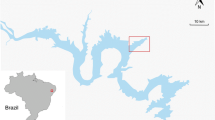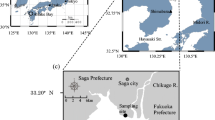Abstract
Danjiangkou reservoir is the water intake of the north-to-south water transfer middle route project and the largest freshwater lake in Asia. According to the operation mode of the reservoir, a large area is formed in the alternating state of drying-flooding annually and this may cause eutrophication in the aquatic ecosystem. The effects of drying-flooding alteration on nitrogen fluxes in the hydro-fluctuation belt of the Danjiangkou reservoir were investigated by conducting three experimental treatments of long-term (LFD), short-term drying-flooding alternating frequency (SFD), and continuous flooding (CF) with indoor incubation experiment. The results showed that the periodic drying-rewetting state is adverse to the ammonium release. The average exchange fluxes of NH4+-N in treatment LFD, SFD, and CF were -10.27, 11.79, and 48.12 mg m−2 d−1, respectively. The varying frequency of periodic drying-flooding had little influence on the exchange fluxes of TDN (FTDN-LFD = -50.52 mg m−2 d−1, FTDN-SFD = -51.60 mg m−2 d−1), but it affected the exchange fluxes significantly for different forms of nitrogenous compounds; the exchange fluxes of ammonium and nitrate in SFD treatment (11.79 and 3.77 mg m−2 d−1) were higher than those in LFD treatment (-10.27 and 0.43 mg m−2 d−1). Ammonium is the main nitrogen form in the bodies of water with long-term inundation; by extending the drying period of the sediment, the ammonium concentrations decreased while the nitrate concentrations increased.









Similar content being viewed by others
Data Availability
The datasets generated during and/or analyzed during the current study are available from the corresponding author on reasonable request.
References
Homberg, A., & Matzner, E. (2018). Effects of drying and rewetting on soluble phosphorus and nitrogen in forest floors: An experiment with undisturbed columns[J]. Journal of Plant Nutrition and Soil Science, 181, 177–184.
Michaels, A. F., Porter, J. H., & Townsend, A. R. (2004). Nitrogen cycles: Past, present, and future[J]. Biogeochemistry, 70(2), 153–226.
Atere, C. T., Ge, T., Zhu, Z., et al. (2017). Rice rhizodeposition and carbon stabilization in paddy soil are regulated via drying-rewetting cycles and nitrogen fertilization[J]. Biology & Fertility of Soils, 53(4), 1–11.
Borken, W., & Matzner, E. (2008). Reappraisal of drying and wetting effects on C and N mineralization and fluxes in soils[J]. Global Change Biology, 14, 1–17.
Bolałek, J., & Graca, B. (1996). Ammonia nitrogen at the water-sediment interface in Puck bay (Baltic Sea) [J]. Estuarine Coastal & Shelf Science, 43(6), 767–779.
Brix H, Schierup H H. Soil oxygenation in constructed reed beds: the role of macrophyte and soil-atmosphere interface oxygen transport[M]. Constructed wetlands in water pollution control. Pergamon, 1990: 53–66.
Burns, L. C., Stevens, R. J., & Laughlin, R. J. (1995). Determination of the simultaneous production and consumption of soil nitrite using 15 N[J]. Soil Biology and Biochemistry, 27(6), 839–844.
Diao, C. T., & Huang, J. H. (1999). A preliminary study on land resources of the water level fluctuating zone in the Three Gorces Reservior[J]. Resources and Environment in the Yangtza Basin, 1, 75–80.
Fierer, N., & Schimel, J. P. (2002). Effects of drying–rewetting frequency on soil carbon and nitrogen transformations[J]. Soil Biology and Biochemistry, 34(6), 777–787.
Hammer, D. A., & Knight, R. L. (1994). Designing constructed wetlands for nitrogen removal[J]. Water Science and Technology, 29(4), 15–27.
Larsen V. Nitrogen transformation in lakes[J]. Proceedings of the Conference on Nitrogen as a Water Pollutant, 2013:419–431.
Lerman A. Migration processes and chemical reactions in interstitial waters[J]. In: Goldberg, et al ed. The sea, Vol 6, New York: Wiley-Interscience, 1977:695–738.
McGowan, S., Leavitt, P. R., & Hall, R. I. (2005). A whole-lake experiment to determine the effects of winter droughts on shallow lakes[J]. Ecosystems, 8, 694–708.
Ma, L., Rena, D., Zhang, M., et al. (2010). Phosphorus fractions and soil release in alternately waterlogged and drained environments at the water-fluctuation-zone of the Three Gorges Reservoir[J]. Journal of Food Agriculture and Environment, 8(3&4), 1329–1335.
Moore, P. A., Jr., Reddy, K. R., & Graetz, D. A. (1992). Nutrient transformations in sediments as influenced by oxygen supply[R]. Crop Science Society of America, and Soil Science Society of America.
Reddy, K. R., Kadlec, R. H., Flaig, E., et al. (1999). Phosphorus retention in streams and wetlands: A review[J]. C R C Critical Reviews in Environmental Control, 29(1), 83–146.
Steinman, A. D., Ogdahl, M. E., Weinert, M., et al. (2014). Influence of water-level fluctuation duration and magnitude on sediment-water nutrient exchange in coastal wetlands[J]. Aquatic Ecology, 48(2), 143–159.
Steinman, A. D., Ogdahl, M. E., Weinert, M., et al. (2012). Water level fluctuation and sediment-water nutrient exchange in Great Lakes coastal wetlands[J]. Journal of Great Lakes Research, 38(4), 766–775.
Small, G. E., Cotner, J. B., Finlay, J. C., et al. (2014). Nitrogen transformations at the sediment-water interface across redox gradients in the Laurentian Great Lakes[J]. Hydrobiologia, 731(1), 95–108.
Timothy, K, Broschat. Rates of ammonium-nitrogen, nitrate-nitrogen, phosphorus, and potassium from two controlled-release fertilizers under different substrate environments[J]. HortTechnology, 2005, 15(2):332–335.
Testa, J. M., Brady, D. C., Di Toro, D. M., et al. (2013). Sediment flux modeling: Simulating nitrogen, phosphorus, and silica cycles[J]. Estuarine, Coastal and Shelf Science, 131, 245–263.
Wang H, Han Y, Pan L. Spatial-temporal variation of nitrogen and diffusion flux across the water-sediment interface at hydro-fluctuation belt of Danjiangkou reservoir in China[J]. Water Science & Technology Water Supply, 2020, 20(4).
Wagner, T., & Falter, C. M. (2002). Response of an aquatic macrophyte community to fluctuating water levels in an oligotrophic lake[J]. Lake and Reservoir Management, 18(1), 52–65.
Zhang, J., Wang, D., & Shi, X. (2004). Change of soil character after flooding in drawdown area of three gorges reservoir[J]. Journal of Soil and Water Conservation, 18(6), 120–123.
Acknowledgements
We are grateful to Shen Zhao, Guohao Li, Kun Lu, and Yakun Wang, from the Water Resources Department of North China University of Water Resources and Electric Power, for their valuable assistance in initially filed work, setting up the experimental mesocosms, and undertaking preliminary monitoring.
Funding
This research was financially supported by the National Science Foundation of China (Grant No.51679089) and the Innovation Foundation of North China University of Water Resources and Electric Power for PhD Graduates.
Author information
Authors and Affiliations
Contributions
Conceptualization: H.W. and Y.P.H; sampling: H.W and Q.W.; incubation experiment: H.W.; sample measurement: H.W.; and writing—original draft: H.W. All authors contributed to the drafting and approval of the manuscript for submission.
Corresponding author
Ethics declarations
Conflict of interest
The authors declare that they have no competing interests.
Additional information
Publisher's Note
Springer Nature remains neutral with regard to jurisdictional claims in published maps and institutional affiliations.
Rights and permissions
About this article
Cite this article
Wang, H., Wu, Q. & Han, Y. Effects of Drying-Flooding Alternation on Sediment–Water Nitrogen Fluxes in Hydro-fluctuation Belt of the Danjiangkou Reservoir. Water Air Soil Pollut 233, 71 (2022). https://doi.org/10.1007/s11270-022-05546-4
Received:
Accepted:
Published:
DOI: https://doi.org/10.1007/s11270-022-05546-4




